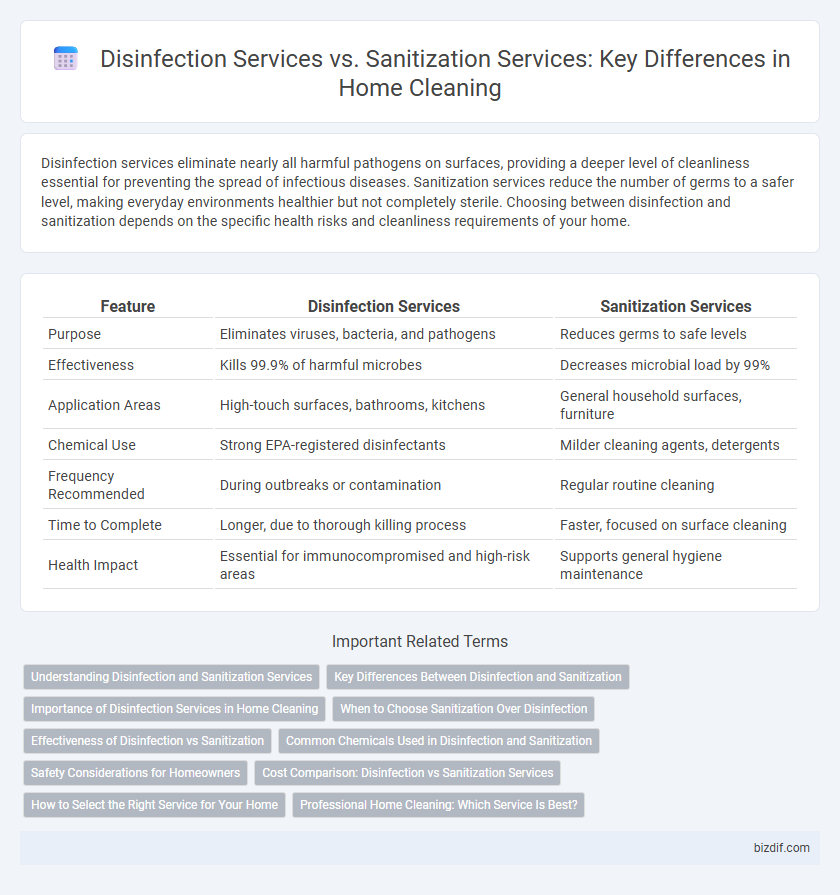Disinfection services eliminate nearly all harmful pathogens on surfaces, providing a deeper level of cleanliness essential for preventing the spread of infectious diseases. Sanitization services reduce the number of germs to a safer level, making everyday environments healthier but not completely sterile. Choosing between disinfection and sanitization depends on the specific health risks and cleanliness requirements of your home.
Table of Comparison
| Feature | Disinfection Services | Sanitization Services |
|---|---|---|
| Purpose | Eliminates viruses, bacteria, and pathogens | Reduces germs to safe levels |
| Effectiveness | Kills 99.9% of harmful microbes | Decreases microbial load by 99% |
| Application Areas | High-touch surfaces, bathrooms, kitchens | General household surfaces, furniture |
| Chemical Use | Strong EPA-registered disinfectants | Milder cleaning agents, detergents |
| Frequency Recommended | During outbreaks or contamination | Regular routine cleaning |
| Time to Complete | Longer, due to thorough killing process | Faster, focused on surface cleaning |
| Health Impact | Essential for immunocompromised and high-risk areas | Supports general hygiene maintenance |
Understanding Disinfection and Sanitization Services
Disinfection services eliminate nearly 99.9% of pathogens on surfaces using EPA-registered chemicals, targeting viruses, bacteria, and fungi to prevent infection spread. Sanitization services reduce the number of germs and microbes to safe levels specified by public health standards, primarily focusing on lowering microbial presence rather than complete elimination. Understanding the distinct roles of disinfection and sanitization helps homeowners select effective cleaning strategies tailored to health safety and maintenance needs.
Key Differences Between Disinfection and Sanitization
Disinfection services eliminate nearly all pathogenic microorganisms on surfaces, targeting viruses, bacteria, and fungi through the use of EPA-registered chemicals with proven efficacy. Sanitization services reduce the number of germs to a safe level based on public health standards but do not guarantee the complete removal of pathogens. Disinfection typically involves longer contact times and stronger agents, making it essential for high-risk areas, while sanitization is suitable for routine cleaning in low-risk environments.
Importance of Disinfection Services in Home Cleaning
Disinfection services eliminate harmful pathogens from surfaces by using EPA-approved chemical agents, crucial for preventing the spread of viruses and bacteria in home environments. Unlike sanitization, which reduces germs to a safe level, disinfection actively destroys almost all infectious microorganisms, ensuring a higher standard of cleanliness and health safety. This is particularly important during flu season, pandemics, or in households with immunocompromised individuals, where effective disinfection minimizes risks of illness.
When to Choose Sanitization Over Disinfection
Sanitization services are ideal for routine home cleaning when the goal is to reduce the number of germs to a safe level and maintain everyday hygiene. Choose sanitization over disinfection when there is no immediate risk of illness or contamination from harmful pathogens, such as during regular upkeep or after minor dirt exposure. For environments with high traffic or vulnerable individuals, sanitization supports ongoing cleanliness without the harsher chemicals used in disinfection.
Effectiveness of Disinfection vs Sanitization
Disinfection services eliminate up to 99.9% of pathogens, including viruses, bacteria, and fungi, by using EPA-approved chemicals that destroy microorganisms on surfaces. Sanitization reduces the number of germs to a safer level but does not guarantee complete eradication of harmful agents, making it less effective for environments requiring high hygiene standards. For thorough protection against infectious diseases, disinfection remains the superior choice due to its comprehensive microbial kill rate.
Common Chemicals Used in Disinfection and Sanitization
Disinfection services commonly use chemicals like sodium hypochlorite, hydrogen peroxide, and quaternary ammonium compounds to eliminate a wide range of pathogens on surfaces. Sanitization services often involve milder agents such as alcohol-based solutions and diluted bleach that reduce bacteria levels to safe standards without necessarily killing all microbes. Understanding the specific chemicals in these processes helps optimize hygiene practices tailored to varied home cleaning needs.
Safety Considerations for Homeowners
Disinfection services use EPA-registered chemicals to kill nearly 100% of pathogens on surfaces, offering a higher level of protection against viruses and bacteria compared to sanitization, which reduces microbial counts to a safer level. Homeowners should consider the safety of chemical agents used, ensuring they are non-toxic and safe for pets and children to avoid health risks. Proper ventilation and adherence to manufacturer guidelines during application are crucial to maintaining indoor air quality and preventing respiratory issues.
Cost Comparison: Disinfection vs Sanitization Services
Disinfection services typically incur higher costs compared to sanitization due to the use of stronger chemicals and specialized equipment designed to eliminate a broader range of pathogens. Sanitization services focus on reducing the number of germs to a safer level, using less intensive products and methods, resulting in lower pricing. Homeowners should weigh the price differences against the level of protection needed, with disinfection offering more comprehensive coverage at a premium cost.
How to Select the Right Service for Your Home
Choosing between disinfection services and sanitization services for your home depends on the level of cleanliness needed; disinfection targets and eliminates a higher percentage of harmful pathogens, making it ideal for homes with vulnerable occupants or recent illness. Sanitization reduces microbes to a safer level for everyday maintenance, suitable for routine cleaning and allergy control. Consider factors such as household health conditions, frequency of service, and specific areas requiring treatment to select the most effective option for maintaining a healthy living environment.
Professional Home Cleaning: Which Service Is Best?
Professional home cleaning requires understanding the difference between disinfection services, which eliminate nearly 100% of germs and viruses on surfaces using EPA-approved chemicals, and sanitization services, which reduce bacteria to safe levels but may not kill viruses. For homes with vulnerable individuals or recent illness exposure, disinfection services are best for maximum protection, while sanitization is ideal for routine cleaning and maintaining healthy environments. Choosing the right service depends on specific health needs, frequency of cleaning, and the type of pathogens targeted in your household.
Disinfection Services vs Sanitization Services Infographic

 bizdif.com
bizdif.com